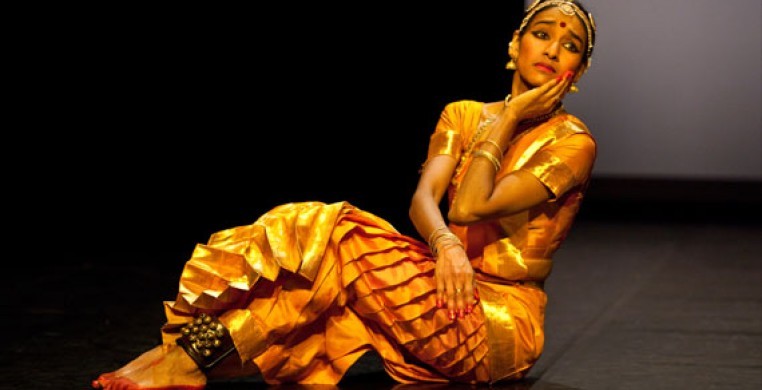Shantala Shivalingappa has been described as “a child of the East and the West,” having been born in Madras and raised in Paris. The revered Indian dancer has championed Kuchipudi, a classical dance that dates back to the 15th century, while showing a penchant for more contemporary experiments: a 2012 performance at the Joyce Theater drew water from the wells of Pina Bausch and the Butoh master Ushio Amagatsu. Shivalingappa recently joined forces with the Memphis jooker Lil’ Buck for a hair-raising duet at the Vail International Dance Festival. She is, indeed, an artist in touch with the powers of old and new, which is what makes her special to watch. On Thursday night at the Dance Center of Columbia College, during the presentation of her evening-length work, Akasha, she was superb.
Kuchipudi originates in the southeastern region of India, centering on two principles: Pure dance and Expressive dance. Like Bharatanatyam—a form well known to Chicago thanks to companies like Natya Dance Theatre and Kalapriya—Kuchipudi is a combination of dance, music and theater rooted in religious narratives. The drama can be celebratory, touching and dreamlike. Like most styles of Indian dance, the distinctions are mainly cosmetic, if not technical, yet Shivalingappa’s gift is to make Kuchipudi feel unique to her alone. She is a charismatic, captivating actor. One might characterize her aura as the Hollywood “it” factor.
Akasha (meaning “sky” or “space” in Sansrkit), centers on five Hindu poems from the 13th to 16th centuries, recited in English translation through recorded voice over. Each text describes various Hindu gods engaged in different scenarios: the god Krishna as mischievous child, Durga as mother goddess, and the quarreling god Venkateshwara as adulterer. Shivalingappa dances and mimes these scenes on stage, one of which features the god Krishna "radiant with beauty” and a “mouth full of mud.” Here Shivalingapa is a watchful mother, playing sitter to an overzealous youngster. She displays maternal affection and childlike innocence with arched eyebrows and big, soulful eyes. In another instance, she imitates Durga, a god that embodies power and the destruction of evil, thrusting a spear towards the ground as if to suggest a conquering hero.
Akasha is said to originate in sound and ever-expanding space. It made sense then to see Shivalingappa in sync with four stellar musicians: a flutist, two drummers and a vocalist. The small ripples of the hands and feet follow syncopated rhythms of drums; melodic chants influence the coded sign language of Shivalingappa’s red-coated fingertips; she is engulfed in time and space.
What makes Shivalingappa stand out is her ability to capture such small, nuanced feelings with a thespian's touch. Her eyes often fill with tangible emotions, her hands more emphatic with each pounding of a drum. My instinct was to believe that these unique qualities were aided by Shivealingappa’s willingness to embrace so many collaborative endeavors, as she’s so often done in recent years, just one possible explanation for such emotional depth. These details don’t go unnoticed. Neither does her strength. A particularly favorite section of Akasha features Shivalingappa balancing on a round brass plate, gyrating her hips and shuffling her way downstage, arms outstretched as if inviting her subjects to participate. She is decidedly vulnerable in this moment. In effortless fashion, Shivalingappa presents herself in reverence to the audience, a divine figure in her own right.
By Matthew de la Peña

